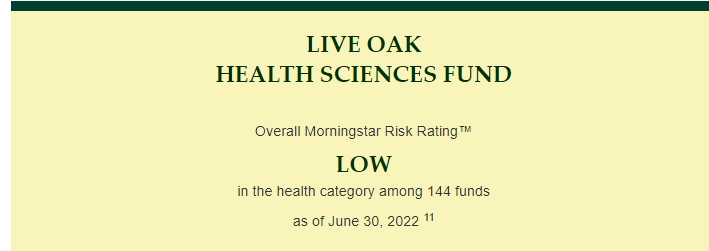Healthcare Sector May Be a Port in the Storm
Insights
Many might well believe the health care sector was a market leader over the last couple of years given how COVID-19 thrust health care companies into the global spotlight. But the health care sector overall actually underperformed the S&P 500 Index during the equity bull markets of 2020 and 2021. However, as market volatility took hold in the first six months of 2022, the more traditionally defensive health care sector significantly outperformed the S&P 500 Index. Here are several reasons why the health care sector may continue to offer both growth potential for your investment portfolio over the long term and a possible port in the storm in the near term.
Recovery Opportunity Health care stocks overall struggled during the pandemic in large part due to postponed elective surgeries, delayed non-emergent procedures and deferred medical exams. However, as restrictions ease, individuals are resuming these foregone appointments driving a rebound for the sector and a runway of potential recovery still ahead.
Historical Outperformance Amid Economic Downturns Health care sector earnings have historically grown when earnings for the broad U.S. equity market have contracted. The 12-month trailing earnings per share (EPS) for the S&P 500 Index* declined by an average of 27.1% during the three pre-pandemic earnings recessions since 2000, while EPS for the S&P 500 Healthcare Index* rose by an average of 14.2% during those same time periods.1
Reduced Inflation Impact Health care costs have been rising for well more than a decade now. So, while elsewhere, businesses are struggling to adjust to a new economic environment of high inflation, health care companies have been operating with increasing cost inputs for years. Also, notably, the inflation rate for medical care commodities and services has actually been significantly lower than that of the broad Consumer Price Index during the last year.2 As the need for health care is rather economy-resistant, the impact of inflation on demand is reduced.pe.
The health care sector hasn’t rebounded as quickly as some other sectors from the COVID-19-driven shutdowns, so we believe there is still great recovery potential ahead and an opportunity for investors to participate in that recovery at compelling valuations.
Robert Stimpson, Co-Chief Investment Officer and Portfolio Manager of Live Oak Health Sciences Fund
Attractive Valuations Outside of a brief period at the outset of the COVID-19 pandemic, health care equity valuations were at the bottom end of their eight-year range as of May 31, 20223—in large part due to concerns in recent years around opioid litigation and whether a new political administration might push through drug price controls. These low valuation levels imply a compelling risk/reward opportunity for long-term investors to increase their portfolio allocations to the sector.
Steady Growth Potential The expectation for earnings and revenue growth of S&P 500 Health Care Index companies in calendar year 2022 is 5.2% and 7.1%, respectively,4 well above the 1.7% annualized growth rate of the U.S. economy projected by the Federal Reserve Board.5
Beneficiary of Shifting Demographics The 65+ population, currently comprising more than 16.5% of the U.S.,6 grew by more than a third during the past decade, driven by the aging of Baby Boomers.7 As more people live longer, there is an anticipated increase in need for health care goods and services.
Inflation won’t affect the consumption of health care since it is needed in strong and weak economic times alike. Also, over the past two decades plus, returns for health care have been among the strongest of all sectors when the S&P 500 Index has declined. That’s why the sector is considered defensive. Plus, the primary drivers of health care demand are secular in nature, so we expect health care stocks to continue to outperform the broader U.S. equity market.
Jeffrey Travis, Portfolio Manager of Live Oak Health Sciences Fund
Exposure to Technological Advances Recent advances in medical technology, such as robotics, gene sequencing, monitoring devices and 3D printing, are expected to increase efficiency, enhance the use of a multitude of medical procedures and provide a new frontier for investors in the health care sector.
Specialized Products/Services Health care companies thrive on innovation, typically offering niche, or specialized, products or services. Notably, in 2021, there were 1,839 merger and acquisition deals made across the health care and life sciences field, compared with 1,618 in 2020 and 1,543 in 2019.8 Deal activity is expected to remain strong in 2022 with the key factors that drove landmark activity, including low cost of capital, pressure to deploy capital, and the needs to sustain innovation, expedite advances and replace lost revenue from maturing products, still in place.
The health care sector is vast, making in-depth research and active, experienced portfolio management key. We believe our focus on seeking health care companies with high quality business models, strong earnings growth and a respect for shareholder value creation can potentially help investors provide some ballast within their portfolios.
Robert Stimpson, Co-Chief Investment Officer and Portfolio Manager of Live Oak Health Sciences Fund
Driven by Secular Demand Trends The health care sector accounts for about 12% of all U.S. jobs9, and health care spending accounts for more than 19.7% of U.S. GDP.10 With demand driven by a number of secular trends, both of these figures are expected to increase. Such secular trends include lifestyle changes that have led to a pandemic of obesity; a growing middle class which implies greater spending on health care and people living longer with chronic diseases and conditions; and the consumerization of medicine wherein individuals take a more active role in stewarding their own health care via evolving health care systems, including telehealth, wearables and other remote patient monitoring tools; and customized, integrated precision health care.
* * *
Past performance is no guarantee of future results, but health care stocks have historically outperformed the broader U.S. equity market over the long term. Those seeking a comparatively defensive sector currently offering compelling valuations might consider a carefully-managed fund of health care stocks as a way to add quality, diversification and growth potential.mid Economic Downturns Health care sector earnings have historically grown when earnings for the broad U.S. equity market have contracted. The 12-month trailing earnings per share (EPS) for the S&P 500 Index* declined by an average of 27.1% during the three pre-pandemic earnings recessions since 2000, while EPS for the S&P 500 Healthcare Index* rose by an average of 14.2% during those same time periods.

Take a Closer Look at the Live Oak Health Sciences Fund to Help You Gain Access to the Health Care Sector
Oak Associates Funds has been specializing in U.S. equity investing for more than 35 years based on an investment philosophy centered on the core tenets of investing for the long term, concentrating in our best ideas and remaining fully invested.
Live Oak Health Sciences Fund invests primarily in the stocks of companies engaged in the research, development, production or distribution of products or services related to biotechnology, health services, medicine or life sciences. Live Oak generally invests in large- and mid-cap companies but can invest in companies of any size.
According to Co-Chief Investment Officer and Portfolio Manager Robert Stimpson, “Our investment process involves identifying what we believe to be the most attractive areas within health sciences. We then narrow the search to individual stocks, paying particular attention to companies that are well positioned to take advantage of technological advances, innovative changes and demographic trends affecting the health care industry. Our stock selection process is based on a quantitative and qualitative analysis of a company’s fundamentals, such as valuation, earnings growth potential, competitive advantages and the quality of management. Now, as the COVID-19 pandemic turns endemic, we expect the health care sector to benefit both from significant investments in the field made during the pandemic and from a normalization in consumer behavior regarding health care services. And so we encourage you to consider increasing exposure to health care stocks as a complement to your portfolio.”
Oak Associates Funds has been specializing in U.S. equity investing for more than 35 years based on an investment philosophy centered on the core tenets of investing for the long term, concentrating in our best ideas and remaining fully invested.
*Earnings per share is calculated as a company’s profit divided by the outstanding shares of its common stock, an indicator of a company’s profitability. Earnings per share for a Standard & Poor’s index measures the overall earnings per share earned from the constituent companies in that index. The S&P 500 Index is an unmanaged index that is representative of the larger-capitalization stocks traded in the U.S. The S&P 500 Healthcare Index comprises those companies included in the S&P 500 that are classified as members of the GICS® health care sector.
1Bloomberg L.P as of July 27, 2020 via seekingalpha.com/article/4371318-5-reasons-to-consider-investing-in-health-care
2www.bls.gov/news.release/cpi.nr0.htm ;
3Bloomberg, May 31, 2022
4FactSet, Earnings Insight, June 17, 202
5www.federalreserve.gov/monetarypolicy/files/fomcprojtabl20220615.pdf
6www.consumeraffairs.com/homeowners/elderly-population-by-state.html
7www.census.gov/newsroom/press-releases/2020/65-older-population-grows.html
8”Investing in a future transformed by the pandemic: 2022 Healthcare and Life Sciences Outlook,” KPMG LLP, 2022.
9www.kff.org ;
10www.insiderintelligence.com/insights/healthcare-industry;
11Morningstar, Inc. is an investment research and investment management firm headquartered in Chicago, Illinois, United States. For Live Oak Health Sciences Fund: Morningstar Risk: Low for the 3-year (144 funds), 10-year (109 funds) and overall (144 funds) periods ended June 30, 2022; Below Average for the 5-year (132 funds) period ended June 30, 2022. All in the health category.
Past performance is no guarantee of future results. Oak Associates Funds are available to U.S. investors only. The thoughts and opinions expressed in the article are solely those of the author as of June 30, 2022.
To determine if this Fund is an appropriate investment for you, carefully consider the Fund’s investment objectives, risk factors and charges and expenses before investing. This and other information can be found in the Fund’s prospectus, which may be obtained from your investment representative or by calling 888.462.5386. Please read it carefully before you invest or send money.
Mutual fund investing involves risk, including the possible loss of principal. Oak Associates Funds are distributed by Ultimus Fund Distributors, LLC. Ultimus Fund Distributors, LLC and Oak Associates Funds are separate and unaffiliated.
Related Information – Download File Here
More News & Insights



